
Community Resource Strategist
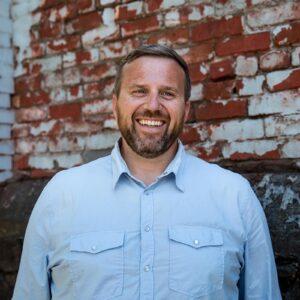
Knowledge Systems Program Director
An aerial photo taken of Kake, Alaska. Photo credit: Bethany S. Goodrich
In the past year, Ecotruster and Keex’ Kwaan Community Forest Partnership Coordinator Miakah Nix has been leading a local field crew in the Tlingit community of Kake, Alaska. Below, Miakah shares highlights and photos from their first field season of the KKCFP, a five-year project to build community capacity for natural resource management and cross-organizational collaboration.
One of Ecotrust’s core values is to collaborate with humility. This idea, in part, drove us to join the Sustainable Southeast Partnership earlier this year. Together, we envision an equitable economy that supports the well-being of the region and its people. We believe that the economic disparity and environmental problems we see currently are the result of business as usual degrading nature and harming people. But, how do you transition away from a winner-take-all economic mindset to one that acknowledges complexity and accounts for the well-being of all people as well as place? For us, it starts with seeking out partners who are doing the hard work on the ground and lending our expertise to produce better outcomes for us all. This is the work we were part of this summer in the village of Kake, Alaska.
With guidance from our partners, we began the initial inventory assessment phase of the Keex’ Kwaan Community Forest Partnership (KKCFP). Major partners and landowners include Sealaska, Kake Tribal Corporation, the Organized Village of Kake (tribal government), and the US Forest Service. This partnership seeks to enhance traditional and subsistence food security, diversify the local economy, develop a natural resource workforce, and invest in tribal sovereignty in the Tlingit community of Kake. KKCFP is not only a science-based, landscape-scale watershed restoration project, but also hugely important because it employs a new, community-based partnership approach to land management.
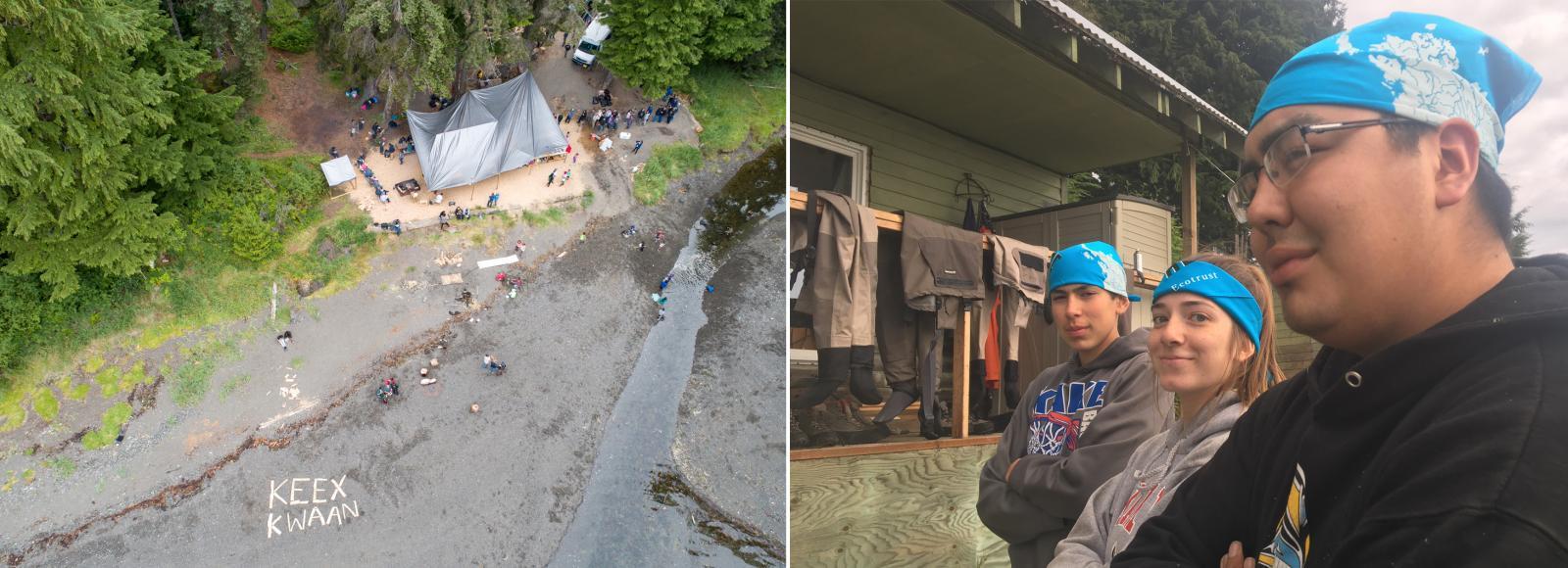
Left: KKCFP technical team member Bob Christensen snaps drone footage of Organized Village of Kake’s Youth Culture Camp. Right: Crew members Shawn Merry, Talia Davis, and Shawaan Gamble-Jackson show off Ecotrust swag in front of the Organized Village of Kake Natural Resource office. Photo credit: Miakah Nix
Over the course of the summer, we worked with a crew to develop new workforce skills while also collecting massive amounts of data—mapping 500 miles of road, noting conditions of 500 stream culverts, and surveying 20 kilometers of extended coho salmon habitat—moving one step closer to a landscape-level watershed inventory.
Keex’ Kwaan is a community with many Indigenous stewards and guardians. The intention of the KKCFP is to enhance this stewardship through local workforce development. Gaining these credentials and technical skills, which are valued by federal and state agencies, lays the foundation for long-term co-management, where locals are enabled financially to manage the lands their families rely on for subsistence, economic security, and cultural continuity. Putting tools in the hands of community members through workforce development is an important piece of the puzzle.
This year we started our workforce development process by hiring five local young people. In partnership with the local tribal government, the Organized Village of Kake (OVK), we focused on local and Native hires. The Field Technicians were selected for their previous field experience and any applicable skills, including familiarity with the landscape and intimacy with the seasonal and customary practices of subsistence harvest of wild game, fish, and berries.
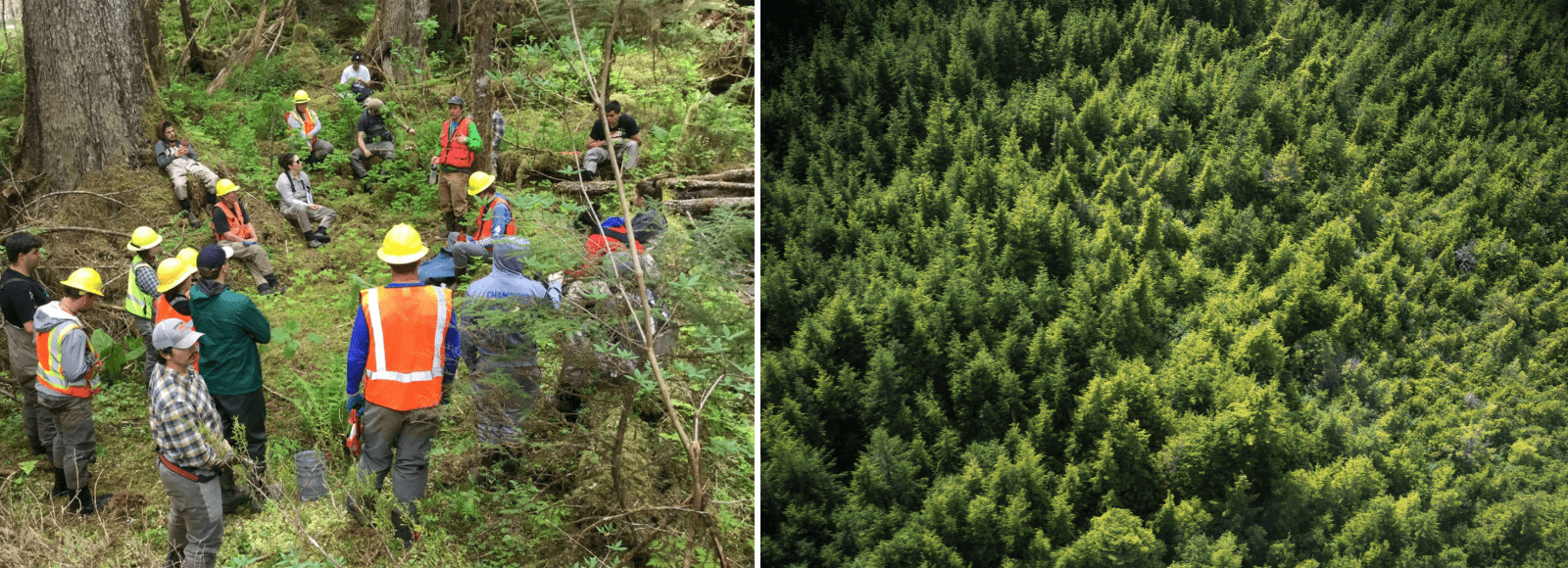
KKCFP rests on the collaboration between many organizations. Thank you, US Forest Service, Spruce Root CDFI, Sealaska Corporation, and Alaska Department of Natural Resources! Left photo credit: Julie Decker; right photo credit: Bethany S. Goodrich
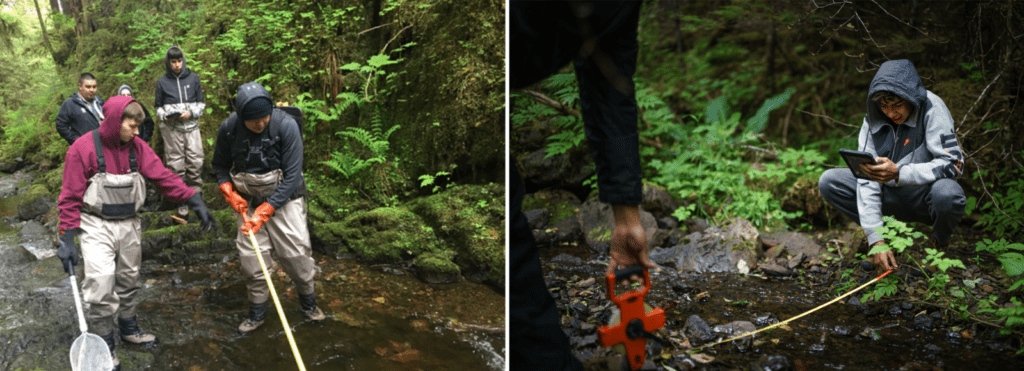
Left: Daniel Ashenfelter and Conrad Revey learn how to use the electrofisher for stream surveys. Photo credit: Miakah Nix. Right: Shawn Merry measures the bedwidth of a stream with the help of a fellow crew member. Photo credit: Bethany S. Goodrich
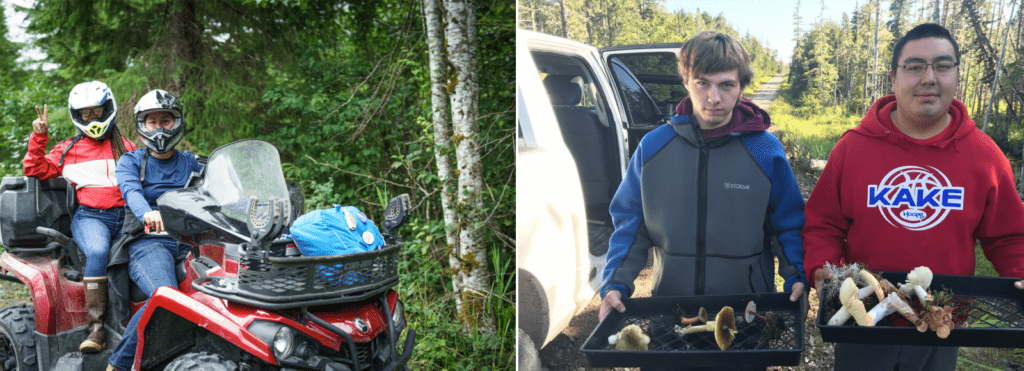
Left: Miakah Nix and OVK Native Connections Youth Co-director Willow Jackson joins the crew to document a day’s work. Photo credit: Bethany S. Goodrich. Right: Daniel Ashenfelter and Shawaan Gamble-Jackson collect mushrooms for a class by USFS Forest Ecologist Karen Dillman.
We began the season with three weeks of intensive training. Ecotruster and KKCFP Coordinator Miakah Nix and the crew attended the 2019 Resource Academy put on by the Alaska Department of Natural Resources and some of the KKCFP partners, including US Forest Service, Spruce Root Community Development Financial Institutions, Sealaska Corporation, and KAI Environmental.
In the first week, we learned rigorous federal and state agency protocols on how to gather stream habitat data, use minnow traps, and safely operate an electrofisher backpack to test for fish presence. In the second week, we learned to conduct forest inventory and non-forest vegetation plots and received training in orienteering and navigation. The third week focused on aquatic organism passage and culvert measurements for water crossing surveys. We then returned to Kake for safety training, where each of our crew members was certified in wilderness first aid. All of this learning is an important step in the workforce development goals of the KKCFP.
“
[It’s] a process of massaging our lands and streams after the damage done from logging. There’s no better feeling than knowing that I’m bringing what I learn in school home to the partnership and helping to restore our lands.
—Shawaan Gamble-Jackson, crew lead
The crew’s initial priorities were to conduct road condition and water crossing surveys. The purpose of the road and water crossing work, focusing on culvert conditions in particular, is to map current road conditions for accessibility and maintenance. In an effort to prioritize future salmon habitat restoration opportunities, Crew Lead Talia Davis oversaw a separate but concurrent effort to complete “End of Anadromy” surveys (EOA). Using electroshocking backpacks, this surveying effort searches for the farthest reaches of Coho fry in local streams. These surveys will be used to verify an anadromous fish habitat model that will be used to help predict fish rearing habitat in local streams. Together, these data sets are part of the larger effort to develop a watershed-wide resource inventory, assessment, and baseline for the project area.

Crew Lead Talia Davis is surveying for Coho salmon fry in local streams, which will help verify a fish habitat model to predict where fish will rear in local streams. Photo credits: Talia Davis
This inventory is the first baseline of its kind to exist in Kake. It is the first step in designing future KKCFP on-the-ground restoration projects and will help leverage for future funding and allocations in local stewardship, land management, and restoration for many years to come. In addition, this inventory can provide critical information for the investigation into the sustainability of new markets in non-timber forest products. These maps have the potential to stimulate an entirely new, community-led forest economy.
A foundational principle of our work focuses on supporting customary and subsistence resource use, traditional cultural lifestyles, and tribal sovereignty. We believe it is necessary to enable our crew to provide for their families and community, even while working a full-time seasonal job. The good weather months are necessary for data collection, but arguably even more important for people’s livelihoods when it comes to Kake’s reliance upon seasonal foods.
Our crew had the privilege to assist the OVK with a host of community and cultural wellness events, including the OVK’s 31st Annual Youth Culture Camp, where local youth learn about traditional food preparation and practice traditional arts and songs and dance. The crew also worked one of the most culturally significant events this summer, the OVK Clan Conference. The Clan conference was the first meeting of all the Keex’ Kwaan Tlingit clan house leaders in decades. Perhaps the most fun day not in the field, we spent beach seining for Coho salmon to distribute to the Elders. We plan to be even more involved in these staple events of the summer in the coming years of the project.
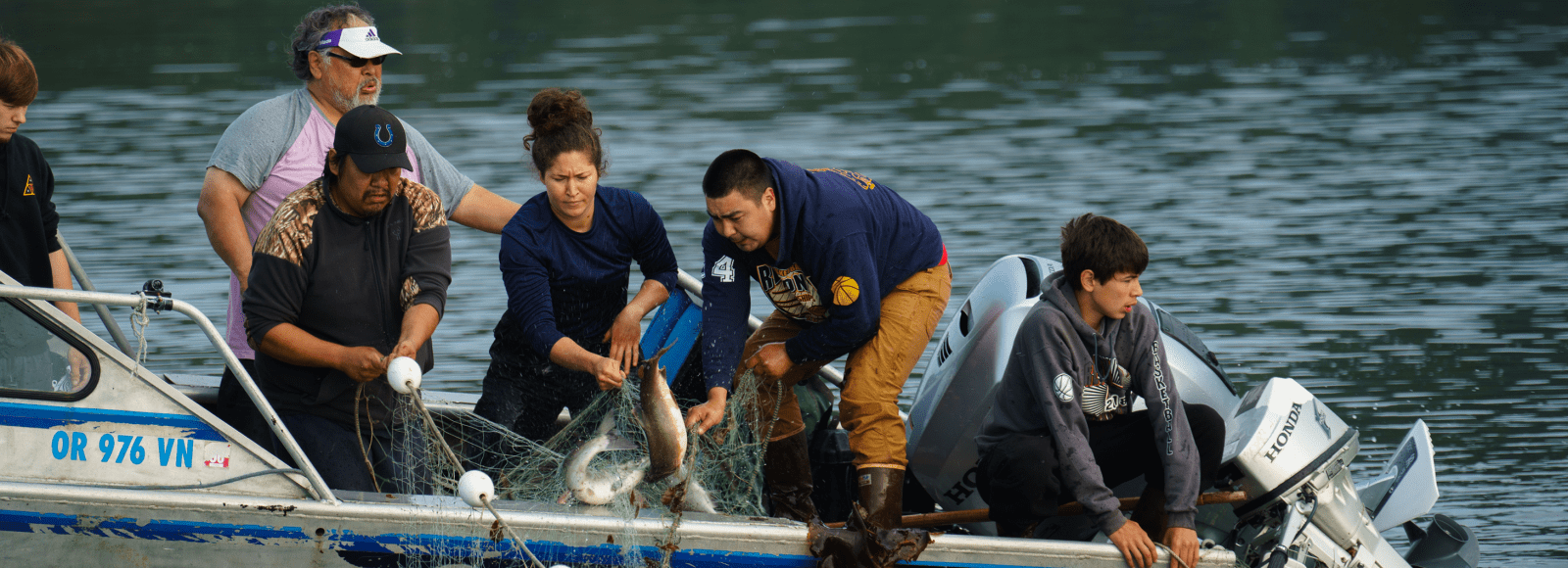
Together with OVK Natural Resource staff and community members, the KKCFP Crew helps beach seine for Coho salmon to provide for Kake Elders. Photo credit: Bethany S. Goodrich
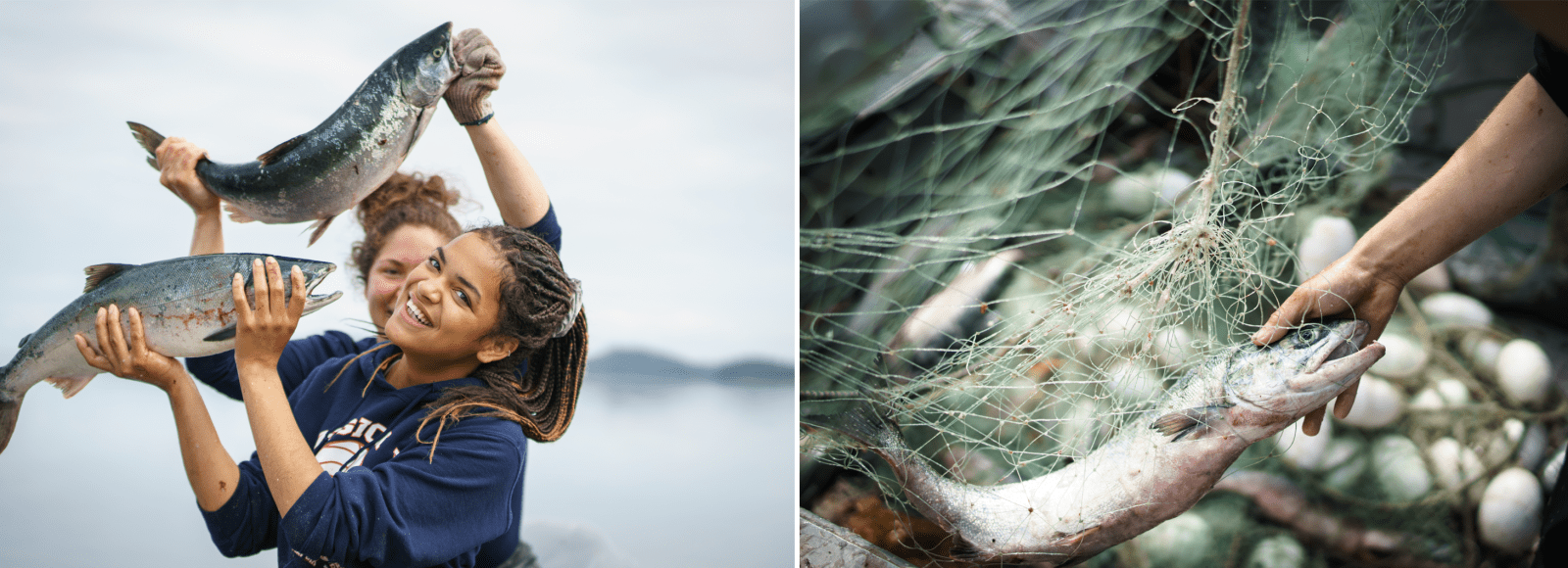
Left: Willow Jackson proudly poses with one of the Coho from a hard day’s work. Right: A Coho salmon caught during the beach seining trip. Photo credits: Bethany S. Goodrich
Crew Lead Shawaan Gamble-Jackson described the work we are doing now as “a process of massaging our lands and streams after the damage done from logging. There’s no better feeling than knowing that I’m bringing what I learn in school home to the partnership and helping to restore our lands.”
This work is important to people on many levels: building climate resilience, ensuring the health and security of traditional foods, medicine, and art; investigating diversified and sustainable renewable energy. But most importantly, this partnership is an opportunity to reinstate the voice of the Keex’ Kwaan community as the foremost authority over their lands.
For updates on our work, follow Keex’ Kwaan Community Forest Partnership on Instagram and Facebook.
Keex’ Kwaan Community Forest Partnership is comprised of these partners:
Organized Village of Kake
Kake Tribal Corporation
Sealaska Corporation
Southeast Alaska Wilderness Exploration, Analysis & Discovery Nonprofit (SEAWEAD)
Ecotrust
Spruce Root CDFI
The Nature Conservancy
Southeast Alaska Land Trust
City of Kake
Alaska Department of Fish & Game
USDA Forest Service
Funding comes from the Natural Resources Conservation Service (NRCS), Regional Conservation Partnership Program

